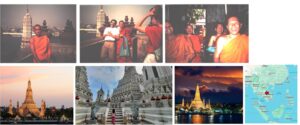Wow Place #290: Wat Arun, Bangkok, Thailand
When I first met Thongsai Monk, high atop Wat Arun, I didn’t completely trust him. Why should I? I’m 24 years old, visiting Thailand for the very first time, and this guy in an orange robe asks me to come home with him.
Don’t jump to conclusions here folks; this isn’t that kind of story. What Thongsai is actually asking me is if I would come back with him to his nearby monastery to teach English to his fellow monks. Hmm, sounds like fun, but can I trust this guy? He certainly looks like a Buddhist monk with his shaved head, his blue shoulder bag, and his orange robes. If I say yes, there are two ways this could go down: Either 1) He’s on the level and I have an authentic intercultural experience, or 2) I’m led down a dark alley where I’m beaten up, robbed, or worse. What would you do?
In the end, I engage in the practice we humans have been doing since our caveman days: I assess the situation and look for danger signs. Are there any concerning patterns here, any anomalies, any metaphorical sabertooth tigers? Is Thongsai wearing anything “non-monk-like,” such as expensive tennis shoes, sunglasses or a Rolex? Nope. Is his English just a little too good? Again nope, he sounds like someone who is learning a foreign language incrementally at his monastery. Is there anything heavy bulging out of his bag that might be a gun or a knife? Not as far as I can tell. Thongsai appears to be what he is.
Again, I’m faced with a choice. Do I: 1) Play it safe? 2) Take a chance and have a potentially remarkable experience? Gathering my resolve, I turn to my new monk friend and say, “Lead on!”
Together, Thongsai and I descend the steep steps of the temple (more of which I’ll discuss later) and plunge into the labyrinthine streets and alleys of the nearby neighborhood. Immediately it becomes clear to me how much of a risk I’m taking here – I will never be able to find my way back on my own! After 20 minutes or so, we arrive at – yes! – what appears to be a monastery. I’m quickly ushered into a small classroom about the size of my bedroom, where I’m faced with 10 smiling, bald, orange-robed monks – anywhere from 15-30 years old – all eager to hear my English lesson. Hooray—it’s all on the level! Oh my, now I have to teach them some English!
Luckily, I’ve spent the last year teaching English in Japan so this is in my wheelhouse. We practice self introductions. I draw a map of the US and show them where I’m from. We practice vocabulary about parts of the body, culminating in a lively session of “Head, shoulders, knees and toes.” In short, I do my full horse and pony show – half English lesson, half cultural stand-up comedy routine. We all have a ball and the hour flies by. When it’s all done, I’m feeling rather sad to be leaving these lovely, earnest students. Lots of handshaking ensues and I’m SO happy I took the chance to say YES to experience and NO to doubt and suspicion.
Afterward, Thongsai walks me back through the maze of streets to our starting point, the Wat Arun, and thanks profusely me for my English lesson. I pump his hand and thank him right back – not for the lesson, but for the opportunity both to trust in human nature and to trust my own gut.

Now, as for Wat Arun – let me tell you, this is one of my favorite places in all of Bangkok. Think of a hybrid between a fairytale castle and a lunar module. Also known as the Temple of Dawn, Wat Arun goes back to at least the mid 17th century. A Buddhist temple, Wat Arun (then called Wat Chaeng) once enshrined the famous Emeral Buddha image before it was transferred to the royal palace.
In 1858 a French explorer wrote:
“Let me add here that Wat Chaeng, the most beautiful temple in Bangkok, is not located in the palace grounds but stands majestically on the right bank of the river. The spire of the pagoda is the first sign to travelers sailing upstream from the mouth of the river that they have arrived in the capital.”
— Henri MOUHOT (1826–61), Voyage dans les royaumes de Siam, de Cambodge, de Laos, 1868.
The main feature of Wat Arun is its central tower, its “prang” – encrusted with colorful shells and porcelain. At nearly 300 feet in size, it’s quite an impressive sight. Around its base are various Chinese soldiers and animals, and around the whole structure stand four more small towers. With a little imagination, you could imagine the whole complex lifting off and hovering over the city. From the river, it’s an exotic dream come true.
As out-of-this-world as the Wat Arun is, however, I think my teaching experience with Thongsai and his band of monks was even better.
(Oscar Wilde once wrote: Never judge anyone shortly because every saint has a past, and every sinner has a future.” Wilde’s point, I think, is to be lenient in your judgments; we’re all human. No one is as bad OR as good as you think they are. And in the case of Thongsai, perhaps it’s better to err on the side of giving people the benefit of the doubt rather than just assuming everyone is out to get you. Not that you want to be a patsy, of course, or plunge into danger without prudence. As President Reagan once said, “Trust but verify.” And when in doubt, trust your gut.)
